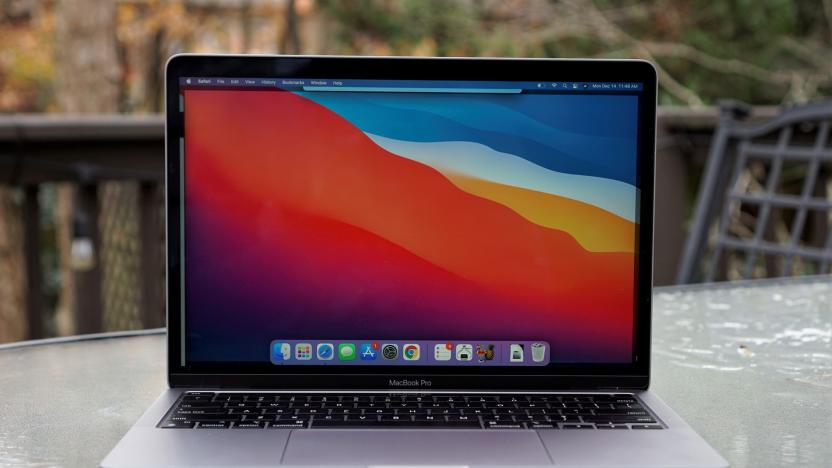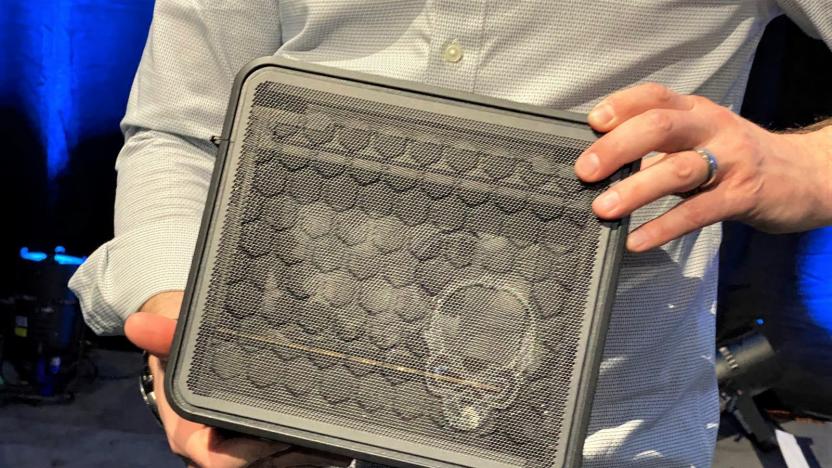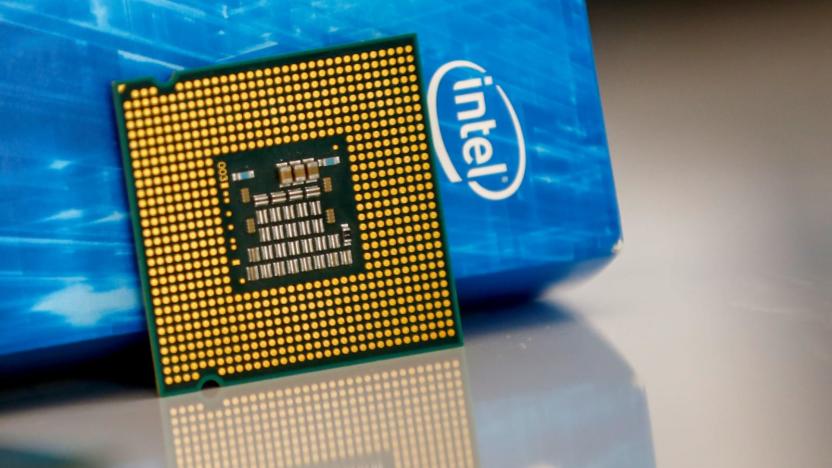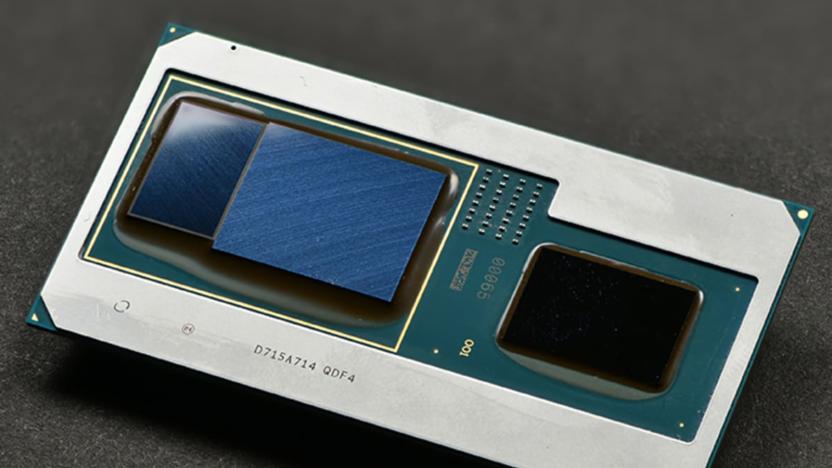core i7
Latest

Intel tries to take down Apple's M1 chip with a flurry of benchmarks
Intel has shared a slew of benchmarks in a bid to downplay Apple's M1 chip, although it's not the resounding victory it appears to be at first.

Watch Intel’s CES 2020 event here at 7PM ET
We're less than an hour away from the start of Intel's CES 2020 keynote. And while it'll probably be hard for the company to match its Project Athena teaser from last year, there are still announcements to look forward to.

Intel 10th-gen desktop chips may pack better multitasking across the board
Intel's 10th-generation Core desktop processors appear to be right around the corner, and the biggest improvements may come to those who don't splurge on the most expensive models. Leaks at Informatica Cero and VideoCardz have detailed a Comet Lake-S CPU lineup where every Core chip, from the i3 to the i9, reportedly includes Hyperthreading. You might not need need to buy a Core i7 or better to wring truly strong multitasking performance out of your system.

Intel discontinues its processors with AMD graphics
If you suspected Intel processors with AMD graphics weren't long for this world, you guessed correctly. Intel has discontinued its Core i7 processors based on Kaby Lake-G, explaining to chip buyers that market interest has "shifted to other Intel products." Vendors have until January 31st, 2020 to place orders, and the last shipments should take place by July 31st, 2020. There's no sign of a replacement on the horizon, either.

Review roundup: Intel's 8-core Haswell-E is the fastest desktop CPU ever
Since it was teased in March, enthusiasts have been itching to see how Intel's 8-core Haswell Extreme Edition processor (the i7-5960X) performs. It has now launched (along with two other Haswell-E models) and the reviews are in. Yes, it's the world's fastest desktop CPU -- but the general consensus is "it could have been better." Why? Because Intel recently launched a "Devil's Canyon" CPU for $340 with a base clock speed of 4.0GHz that can easily be overclocked to 4.4GHz. The $1,000 Extreme Edition chip, on the other hand, has a base clock of 3.0GHz and max turbo speed of 3.5GHz. Since clock speeds are often more important to gamers than multiple cores, that might disappoint many a Battlefield 4 player. On the other hand, with DDR4 support and eight cores (Intel's highest count ever on the desktop), the chip should excel at pro tasks like 4K video processing and 3D rendering. Given the price tag, that might be the only market that can afford it. Here's what the experts think.

Haswell-equipped 15-inch MacBook Pro appears in Geekbench report
It's hardly a matter of "if" -- it's simply a matter of "when." Now that Intel's Haswell CPU has found its way into the MacBook Air line, it's a given that Apple engineers are actively looking for ways to cram that very silicon into the rest of its laptop range. If a newly uncovered Geekbench report is to be believed, it looks as if the 15-inch MacBook Pro could be next in line. The report (pictured in full after the break) details a machine packing a 2.4GHz Core i7-4950HQ and 16GB of RAM, and while there's no discrete GPU shown, Primate Labs' John Poole has informed MacRumors that the benchmark may have simply missed it during testing. At any rate, the score itself isn't anything to write home about -- it's pretty much in line with the existing generation of MBPs -- but the real magic is apt to reside in the eventual battery life claims. If the next-generation Pro follows the Air, we'll see similar performance and nearly twice the longevity. Mission accomplished.

Intel sets Haswell launch for June 4th, details bold battery life claims
Haswell is hardly a secret at this point: there's been a steady drip-drip of demos and technical leaks since as far back as 2011, and just a month ago we brought you the low-down on its integrated graphics. But today, finally, we have official pricing for a number of variants, a concrete date for availability (this coming Tuesday, June 4th) and, perhaps most importantly, some detailed benchmark claims about what Haswell is capable of -- particularly in its mobile form. Sure, Intel already dominates in MacBooks, Ultrabooks (by definition) and in hybrids like Surface Pro, but the chip maker readily admits that the processors in those portable PCs were just cut-down desktop chips. Haswell is different, having been built from the ground up with Intel's North Cape prototype and other mobile form factors in mind. As a loose-lipped executive recently let slip, we can look forward to a 50 percent increase in battery life in the coming wave of devices, with no loss of performance. Read on and we'll discover how this is possible and what it could mean for the dream of all-day mobile computing.%Gallery-189926%

MacBook Pro with Retina display review (13-inch, late 2012)
Look down the aisles at any Apple launch event, across the laps of dozens of journalists liveblogging or in some other way documenting the goings-on, and it's inevitable that you'll see MacBooks. A lot of MacBooks. And, since many of those laps are irrevocably linked to owners who spend their days jetting around the globe to other companies' events, those laptops are quite often the travel-friendly MacBook Air. So, while we were excited to see a thinner, lighter 15-inch MacBook Pro with Retina display unveiled earlier this year, many of us were left asking one question: "Where's the 13-inch version?" Now, a little over four months later, here it is. Why the wait from one to the next? That's for Apple to know and us to speculate about (supply chain concerns? engineering issues?), but the important thing is that it's available now and it is, in many ways, an uncompromised, slightly smaller rendition of the 15-inch version that came before. It's thinner and it's lighter than the current 13-inch Pro but promises better internals and the same battery life as the 13-inch Air. Perfect portions of portability and performance? Let's find out.

Digital Storm Bolt stuffs full-power graphics into a mini gaming desktop, stretches laws of physics
Attempts to create truly small gaming desktops usually involve at least some kind of performance hit. Even HP's category-bending Firebird, one of the few stand-out examples, had to use toned-down graphics to succeed in a tiny enclosure. Digital Storm might have broken the trend towards sacrifice with its new Bolt desktop: although it's just 3.6 inches wide and 14 inches tall, the Bolt can cram in as much as a GeForce GTX 680 and will even let gamers upgrade the graphics like they would in a full-size PC. The seemingly logic-defying (if also finger-defying) case still allows room for as much as an overclocked 4.6GHz Core i7, 16GB of RAM and storage options that meld a spinning hard drive with up to two SSDs and a DVD burner. Digital Storm isn't even setting an absurd base price, but it's in the cost that we finally see the catch to the miniaturization tricks. The $999 entry-level Bolt carries a modest 3.1GHz Core i3, 8GB of RAM, a 1TB hard drive and GeForce GTX 650 Ti, while it takes a staggering $1,949 to get a fully decked-out Core i7 system with a GTX 680. Those prices might be worthwhile for anyone who has ever strained while lugging a traditional tower to a game tourney. %Gallery-169137%

Apple unveils next-generation iMac with slimmer design and Ivy Bridge, starting at $1,299
Who said Apple's event was all about the little things? Apple just unveiled its first redesign to its iMac desktop in three years. The new all-in-one makes the widely expected leap to Intel's Ivy Bridge Core i5 and Core i7 processors, but also represents a much leaner and meaner replacement for the 2009-era template -- its edges are just 5mm thick, and it's constructed with "friction stir welding" as well as a gapless, less reflective display that's laminated together with the glass. Screen sizes remain the same and include both a 21.5-inch, 1080p model and a 27-inch, 2,560 x 1,400 model -- sorry, no Retina displays this year. They share 720p-capable front cameras with dual mics as well as NVIDIA's GeForce 600-era graphics, up to 32GB of RAM and a panoply of storage options that peak at 3TB of spinning storage, a 768GB SSD or what Apple calls a Fusion Drive that mixes both 128GB of flash with 1TB or 3TB of conventional storage (a hybrid drive, for those of us who've seen it before). There's no optical drive unless you plug in a USB option. The 21.5-inch model ships in November, and will set you back $1,299 for a 2.7GHz Core i5, 8GB of RAM and a 1TB hard drive; pony up for the 27-inch model at $1,799 and you'll get a 2.9GHz Core i5 as well as the same memory and storage. Apple's larger iMac doesn't ship until December, however, which will give some impulse buyers at least a brief respite. %Gallery-169056% For more coverage, visit our Apple Special Event hub!

Acer unveils space-saving ME mini tower and XC desktops for (low) power users
The arrival of Windows 8 is a good excuse for the PC industry to flood the market with so much hardware, consumers will be blinded by so much choice. Acer's jabbing its digits into your eyes with its new lineup of low-end desktops for the casual user. The ME micro towers will take an Intel Core i5 or I7, 2TB HDDs and up to 16GB of RAM. If you don't have anywhere else to stash your smartphone, the chassis comes with a recess desk on top with a USB port for easy charging. Those looking for something a little less demanding can pick up an XC desktop, a space-saving unit that will take an Intel Core i3, a 1TB HDD and up to 6GB of RAM. Prices for the ME begin at $700, while the cheaper XCs will set you back a much more modest $400.

Engadget Giveaway: win an exclusive Atari 2600 with PC components!
We're not going to beat around the bush here: this is one of the most exciting contests we've hosted in a long, long time, and you'll definitely want to enter. Our friends at Atari were kind enough to give us an extremely limited-edition (there are only two in existence) Atari 2600 gutted with modern PC components and signed by Atari founder Nolan Bushnell -- and one lucky soul will be able to call this beauty their very own! The gaming company is doing this to promote the 35th anniversary of the 2600's original release, as well as its latest creation, arcade.atari.com, which is an HTML5-driven, multitouch-supported hub that lets you play eight classic Atari games online (including Pong and Centipede). Not only that, the team -- consisting of Atari and the Internet Explorer team -- put together an SDK to help you build your own games on the classic platform. After you enter to win (all you have to do is leave a comment below), make sure you head over to the Arcade to spend countless more hours in the land of nostalgia. Note: For bragging rights, feel free to post your high score as your comment entry.

ASUS TAICHI 21 and VivoBook X202 go up for US pre-orders, spoil the party a bit early (update: VivoTab RT, too)
Just because ASUS has planned a grand October 23rd event to outline its US Windows 8 lineup doesn't mean we can't get an advance peek. Pre-orders have officially kicked off for at least two touchscreen PCs that also give us a very good feeling for the hardware we'll see at our doors. The dual-screened TAICHI 21 is naturally the star of the show, but it will cost you: a base version of the 11.6-inch hybrid with a 1.7GHz Core i5, 4GB of RAM and a 128GB SSD starts at $1,300, while an uprated model with a 1.9GHz Core i7 and a 256GB SSD will set early adopters back by $1,600. We'd say the VivoBook X202 is more likely to get some purchases sight-unseen at $600 for an entry laptop with an 11.6-inch touchscreen, a 1.8GHz Core i3, 4GB of RAM and a conventional 500GB hard drive. Both of the systems should arrive in tandem with Windows 8's October 26th launch and compound the traffic jams for couriers and retailers on what could be a very busy day. [Thanks, Donny] Update: As Computerworld noticed, Newegg also has a pre-order listing for the VivoTab RT, which costs $599 in its lone 32GB configuration. It ships the same day as its bigger cousins.

Kupa UltraNote Windows 8 modular tablet hands-on (video)
Keep lurking long enough and you'll find the unexpected. Even at MobileCon 2012. Exhibit A: the Kupa UltraNote modular tablet running Windows 8. This 0.6-inch (15mm) thick slate is powered by an Intel Core i7 processor (Ivy Bridge) with 4GB of DDR3 RAM and a 64GB SSD. It features a 10.1-inch 1920 x 1200-pixel IPS display with a ten-point capacitive multitouch layer and a Wacom-like digitizer for pen input. Other amenities include WiFi a/b/g/n, Bluetooth 3.0 and 3G/4G (LTE) radios along with dual cameras (2MP in front, 5MP in back), NFC and a fingerprint reader. There's a SIM slot, headphone jack, mini HDMI output and two USB 3.0 ports on the right side of the device, plus a proprietary power / docking connector on the bottom edge. A 45Wh slide-out Li-Ion battery is located on the left side. While the specs are pretty much what you'd expect from a decent Windows 8 tablet, it's the modular design that makes Kupa UltraNote unique. There's an Asus Transformer-like keyboard dock which boasts an additional battery, power jack, SD card slot, Ethernet connector, VGA output and two USB 3.0 ports. Accessories such as credit card reader can be attached the left or right edge of the slate thanks to a built-in latch mechanism. It's clear that the company is targeting the enterprise and vertical markets and even positioning itself as an ODM. We spent a few minutes with the device and were impressed with how lightweight it was (760g / 1.67 lbs). Build quality, however, left a lot to be desired, even for a prototype. Still, overall performance was solid, both in terms of speed and responsiveness. There's no word yet on pricing and availability, but take a look at our gallery and be sure to peek after the break for our hands-on video. Brad Molen contributed to this report.

Panasonic shows off foldable Windows 8 Ultrabook hybrid, launches October 26 (hands-on)
Found along the sidelines of Panasonic's CEATEC booth, the AX series Ultrabook is a foldable hybrid that will be arriving in Japanese stores later this month. Ready to launch with Windows 8 (both standard or Pro) built-in, the Ultrabook houses a 11.6-inch touch display at the ever-popular 1,366 x 768 resolution, although it feels a little on the thick side, and is unmistakably Panasonic in its styling. Connectivity options are legion, with two USB 3.0 ports on the right edge, accompanied by HDMI socket. On the other side, there's an SD card reader, ethernet, power, mic and headphone ports. The hinge seems suitably solid, and while that touchscreen isn't the most attractive we've seen on Windows 8 hardware, the keyboard felt pretty similar to existing business laptops and our fingertips had plenty of space. Otherwise, we were left to play with a Japanese iteration of Windows 8, which seemed nice and responsive in both tablet and notebook setups, although our playtime was limited. The AX series will launch in Japan on October 26th in three different permutations, starting with an Intel Core i5 processor clocked at 1.7GHz or 1.8GHz, and a Core i7 at 1.9GHz. There's 4GB of memory and a 128GB SDD in all three, while the hybrid bucks the trend by offering a removable battery, with both the faster Core i5 and the Core i7 models coming with an extra cell bundled in. That top-end processor will also arrive with connectable projector for business types. Check out our brief hands-on after the break, or hit the source for the full list of specs.

Dell's Latitude 10 tablet and dock, OptiPlex 9010 AIO, Latitude 6430u laptop arrive to tempt business pros
Windows 8 is coming folks, and so is an onslaught of new machines featuring Microsoft's something-for-everyone OS. Dell already showed us some of its fresh consumer Win8 hardware back at IFA 2012, and now it's the enterprise's turn to shine. First up is the Latitude 10 tablet, which packs an Intel Atom SoC, a 10.1-inch IPS 1366 x 768 LCD display covered in Gorilla Glass, 8-megapixel primary camera plus an HD front-facing shooter. It's got 2GB of RAM and up to 128GB of eMMC NAND storage, plus an SD card slot should the integrated storage prove insufficient. Connectivity comes via one full-size USB 2.0 port, a microUSB charging socket, mini-HDMI, a headphone/microphone combo jack, proprietary docking port and a micro-SIM slot for WWAN use. The Latitude 10 packs up to a 60Wh battery, which isn't remarkable in and of itself, but the fact that it's removable is. That means road warriors can travel with a spare cell or two to keep their slate in the juice no matter how long they work on it. While the swappable battery can keep the 10 from being tethered to an outlet, the dock Dell built for it ensures it'll have a stylish place to rest when it is. The dock expands the slate's connectivity with four USB 2.0 sockets, Gigabit Ethernet, HDMI and audio output.%Gallery-165869% Next is the Optiplex 9010 all-in-one desktop we saw earlier this year. It still has the same 23-inch, 1920 x 1080 panel on the front and vPro-equipped Ivy Bridge silicon lurking beneath -- the only change is the upgrade from Windows 7 to Windows 8. The Latitude 6430u is an addition to Dell's venerable business laptop line, and is the first to bear the Ultrabook moniker. It's generous to label the 6430u as such, as it's .82 inches thick and weighs 3.7 lbs, but it's still a fairly thin and light laptop -- plus it has the same solid magnesium chassis construction as its Latitude brethren. The 6430u crams a 14-inch, 1366 x 768 matte display into its 13.3-inch chassis, and users have the option of Ivy Bridge Core i3, i5 and i7 silicon with vPro, up to 8GB of RAM and up to 256GB worth of solid state storage. Naturally, there's 802.11 b/g/n WiFi, Bluetooth and mobile broadband available for wireless connectivity. Unfortunately, we can't tell you how much Dell's new business computers will cost, but we do know that they'll be available when Windows 8 is, which is to say late October.%Gallery-165871%

Intel expands 3rd-generation CPU range, announces new 3GHz Core i7 Extreme Edition mobile processor
Intel's quad-core Ivy Bridge processors have been doing the rounds since April, but the chipmaker continues to expand its selection, now adding a new high-end Core i7 mobile processor. Clocked at 3.0 GHz and priced at $1,096, the Core i7-3940XM is a quad-core 22 nm chip, packing Intel's HD 4000 series GPU and 8MB of L3 cache. According to the recently revealed pricing list, it'll be joined by two more Core i7 models, the 2.8GHz i7-3840QM and the 2.7 GHz i7-3740QM. If you're shopping around for a new processor, visit the source for the full list of Intel's newest entries -- alongside some minor price reductions on a few older models.

Sony VAIO Duo 11 slider PC hands-on (video)
While Sony's keeping quiet on a lot of the precise technical specs, there's plenty to talk about in the form-factor Sony has chosen for one of its debut Windows 8 VAIO devices. The Duo 11 slider pairs an 11.6-inch screen with a sliding -- and very satisfying -- hinge. This gives the slate two different ways to deal with Microsoft's forthcoming OS. Handily, Sony has also developed a precise digitizer to work in tandem with the device. We're liking the style of the slider, and that petite footprint is also rather appealing -- aside from the paucity for keys. There are more impressions and a hands-on video after the break. %Gallery-163684%

Sony unveils VAIO Duo 11 slide-out tablet, Tap 20 portable touchscreen all-in-one
Sony just threw itself fully into the touchscreen Windows 8 arena -- it's introducing the VAIO Duo 11 slider tablet and the Tap 20 combination desktop and tablet design at its IFA 2012 press conference. The Duo 11 is a noticeably amped-up realization of the Hybrid concept we saw at CES. Its 11.6-inch, 1080p touchscreen is joined by a proper digitizer stylus for low-lag handwriting as well as some seriously powerful innards for a convertible PC its size: we're talking an Ultrabook-level Core i3, i5 or i7 as well as a 128GB or 256GB SSD, NFC wireless, GPS, and HD-capable cameras at the front and back. Sony is hoping for a late October release for this beast of a slate, although we haven't been given that all-important price. The VAIO Tap 20, meanwhile, is more than just a tilting all-in-one desktop in the vein of Lenovo's IdeaCentre A720. Despite carrying a 20-inch, 1,600 x 900 touchscreen, it's still very much battery-powered -- you can lug the 11.4-pound PC into the living room and treat it like a tiny multi-touch table, if that's your inclination. It's sharing the same processor picks as the Duo 11, but it turns to more conventional 750GB or 1TB hard drives and puts the emphasis on shareable apps like Family Paint and the Fingertapps Organizer calendar. Not surprisingly, there's only one, front-facing 1.3-megapixel camera here, although NFC does make the cut. The Tap 20 is due to arrive at about the same time as its smaller Duo 11 sibling, although we're once again without details of how much it will cost. %Gallery-163639% %Gallery-163640%

Gigabyte P2542G gaming laptop hands-on (video)
While we managed to get our hands on Gigabyte's latest graphics card-toting Ultrabook back at CeBIT, we've just finished handling the P2542G (its high-end gaming sibling) at the laptop and motherboard maker's UK launch event. Packing a 15.6-inch 1,920 x 1,080 display, it runs on an Ivy Bridge Core i7-3610QM, with a 2GB NVIDIA GTX 660M card to power PC gaming's latest and greatest. Add in a Blu-ray player and THX-certified dual-woofer sound system and you have the makings of pretty capable beast -- not to mention looking the part with a yellow paint job and dual exhaust vents along the back edge. Read up on our impressions and check out our video hands-on after the break.%Gallery-163222%









